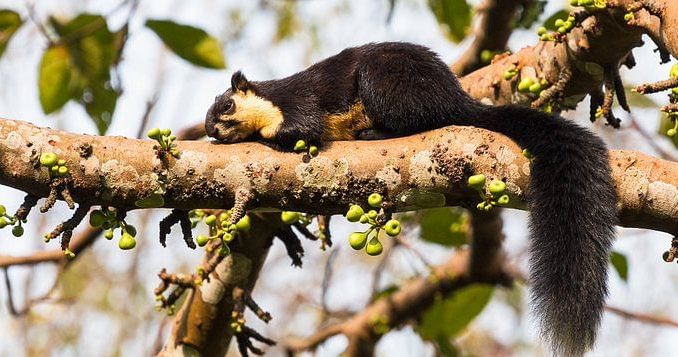
In News
The first-ever study on the Malayan Giant Squirrel, one of the largest squirrels in the world, found that it is disappearing in the wild at a fast pace.
In-Detail
- The Malayan Giant Squirrel (Ratufa bicolor) is found in parts of West Bengal, Sikkim, Assam, Nagaland, Meghalaya, and Arunachal Pradesh.
- It has a dark upper body, pale underparts, and a bushy tail.
- The squirrel is a “forest health indicator species”.
- As per the study conducted by the Zoological Survey of India (ZSI), it is fast disappearing from the forests of the Northeast where it is native.
- It is estimated that by the middle of this century, the squirrel may become extinct in the wild.
- As per ZSI, by 2050, the squirrel population could reduce by 90% in India and in the subsequent decades will become extinct.
- The major threat to the survival of the giant squirrel is the destruction of its habitat.
- As per estimates, by 2050, the squirrel will be restricted to the forests of southern Sikkim and North Bengal.
- The study found that currently, only 43.38% of the original habitat of the Malayan Giant Squirrel is favorable to it, which will shrink to 2.94% by 2050.
- This is the first-ever study on Indian giant squirrels which made the researchers realize that the Malayan Giant Squirrel is losing its territory to human settlements and cultivation.
Critical To Forests
- India has three giant squirrels – the Indian Giant Squirrel, the Grizzled Giant Squirrel, and the Malayan Giant Squirrel.
- According to researchers of the study, if conservation efforts are not taken immediately, we may lose the Malayan Giant Squirrel altogether.
- Giant squirrels are diurnal, arboreal (tree-dwelling), and herbivorous.
- The health of the species indicates the health of the forests.
- They are known as indicator species because they determine the health of the vegetation in the forest, the plant species that they feed on, and the symbiotic species that depend on these plants.
- The Malayan Giant Squirrel is also found in Southern China, Thailand, Vietnam, Laos, Burma, Malayan peninsula, Sumatra, and Java.
- The species is found in plains and hills with an altitude difference of 50m and 1500m.
- They inhabit evergreen and semi-evergreen forests.
- About 20% of the Malayan Squirrel population in India is found between altitudes 1500m and 2700m above sea level. The rest are found in the plains and upto 1500m.
- India constitutes 8.5% of the Squirrels range in Asia.
- The IUCN’s Red List of 2016 had placed the species in the Near Threatened category, as such the species is protected under the Wildlife Protection Act of India.
- In the last two decades, the population of the species had declined by 30% in India.
- From 1987 to 2013, the Northeast region has gained 7,172 sq. Km of forests, but in the last two years, it has lost 628 Sq. Km of forests.
Major Threats
- Researchers identified the following as the major threats to the species:
- Slash and Burn Cultivation (Jhum cultivation)
- Deforestation
- Forest Fragmentation
- Food Overharvesting
- Crop Cultivation
- Illegal Wildlife Trade
- Hunting for consumption

Leave a Reply
You must be logged in to post a comment.